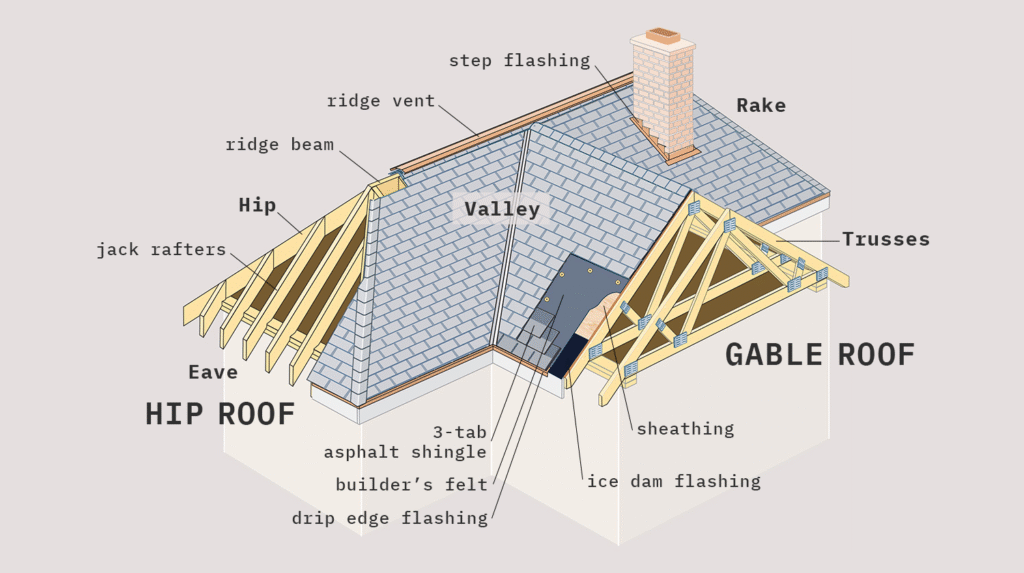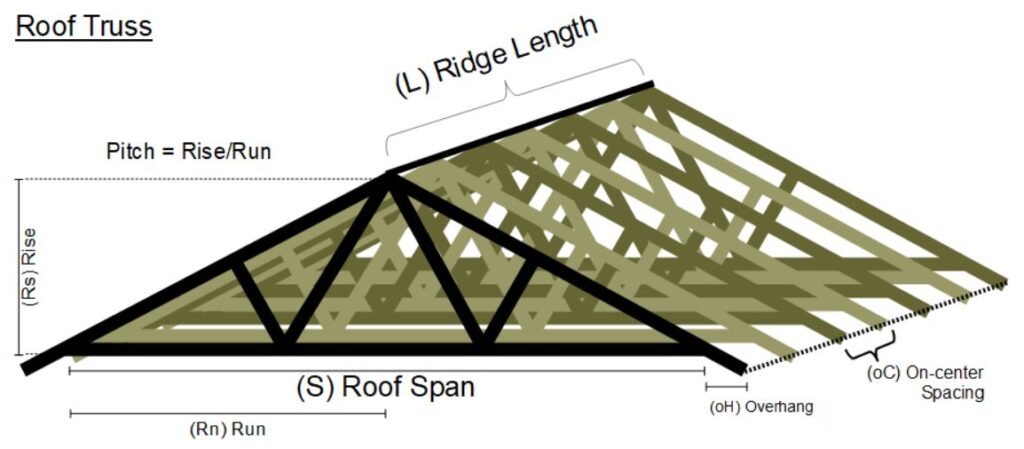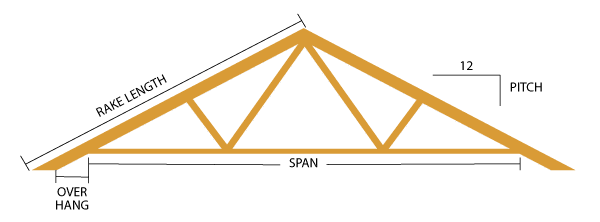Roof Truss Calculator A roof truss calculator helps determine the number of roof trusses needed for a building project. These calculators typically require the roof’s length and the desired spacing between trusses (on-center spacing) as inputs. The output is the estimated number of trusses required for the roof structure.
Professional Roof Truss Calculator
An intuitive tool for estimating truss dimensions, material needs, and project costs.
Dimensions
Materials
Project Estimates
Truss Geometry
About Truss Designs
Each truss design offers unique structural benefits and is suited for different applications. The “Lumber Multiplier” is a simplified factor used to estimate the total linear feet of lumber required for a single truss based on its width and complexity.
- King Post: The simplest truss, featuring a central vertical post. Ideal for short spans like small sheds, garages, and decorative gables.
- Queen Post: Uses two vertical posts, creating a stronger design for medium spans. A very common and versatile choice for workshops and larger garages.
- Fink Truss: Recognized by its internal “W” shaped webbing. This highly efficient design is one of the most popular choices for residential roof construction.
- Howe Truss: Features vertical members in tension and diagonal members in compression. Historically used for bridges, it’s also excellent for buildings requiring support for heavy loads.
- Scissor Truss: Designed with sloped bottom chords that create a dramatic vaulted or cathedral ceiling inside the building, adding aesthetic appeal at the cost of more complex framing.
Common Project Examples
Below are typical dimensions for common building projects. In a future update, you’ll be able to click these to automatically load the values into the calculator.
- Standard Garden Shed: A simple and functional structure. Recommended Specs: 12ft Width, 16ft Length, 4:12 Pitch, 0.5ft Overhang, King Post Truss.
- Two-Car Garage: A common residential size that requires a sturdy, standard truss. Recommended Specs: 24ft Width, 24ft Length, 6:12 Pitch, 1.5ft Overhang, Fink Truss.
- Large Workshop/Barn: A larger building that benefits from a strong and efficient design. Recommended Specs: 30ft Width, 50ft Length, 8:12 Pitch, 2ft Overhang, Howe or Queen Post Truss.
Important Disclaimer
This calculator provides estimates for planning and budgeting purposes only. Always consult a qualified structural engineer to obtain plans that comply with local building codes, snow loads, and wind conditions before construction.
Understanding Roof Truss Calculators
When it comes to building or renovating a house, the roof is one of the most critical components. A well-designed roof ensures structural integrity, weather protection, and aesthetic appeal. One essential tool that builders, architects, and DIY enthusiasts use to streamline the roof design process is the roof truss calculator.

What is a Roof Truss Calculator?
A roof truss calculator is an online or software tool designed to help users determine the dimensions, materials, and layout required for roof trusses. Roof trusses are pre-fabricated wooden or metal frameworks that provide support for the roof covering and transfer loads to the building’s walls or foundation.
Traditionally, calculating the specifications for roof trusses required manual measurements and complex engineering knowledge. Today, roof truss calculators simplify this process by automating the calculations based on user inputs.

How Does a Roof Truss Calculator Work?
Most roof truss calculators ask for several key inputs, including:
- Span: The distance between the two supports of the truss.
- Pitch: The angle or slope of the roof.
- Overhang: The length of the roof that extends beyond the walls.
- Spacing: The distance between individual trusses.
- Material type: Wood or metal options.
Based on these inputs, the calculator generates detailed specifications such as:
- Lengths of each truss member.
- Number of trusses required.
- Load capacity and weight estimations.
- Suggested materials and quantities.
Benefits of Using a Roof Truss Calculator
- Accuracy: Reduces human error in complex calculations.
- Time-saving: Quickly provides detailed plans without manual drafting.
- Cost Efficiency: Helps optimize material usage and avoid wastage.
- Accessibility: Allows non-engineers to participate in planning and design.
- Customization: Enables adjustments to suit architectural preferences and local building codes.
Who Should Use a Roof Truss Calculator?
- Builders and contractors: For precise planning and ordering of materials.
- Architects and engineers: To validate design choices and structural safety.
- DIY homeowners: To assist with home improvement projects.
- Students: For educational purposes in construction and civil engineering courses.
Tips for Using a Roof Truss Calculator Effectively
- Always double-check inputs for accuracy.
- Understand local building regulations and ensure compliance.
- Use the calculator as a guide but consult a licensed structural engineer for final approval.
- Consider environmental factors like snow load, wind speed, and seismic activity.
Conclusion
Roof truss calculators are invaluable tools that bring efficiency and precision to roof design. Whether you are a professional or a homeowner, leveraging these calculators can save time, reduce costs, and ensure your roof is both strong and durable. As technology advances, these tools continue to become more accessible and user-friendly, empowering more people to engage confidently in construction projects.

Explore various roof truss calculators online and take the first step towards a well-designed roof today!